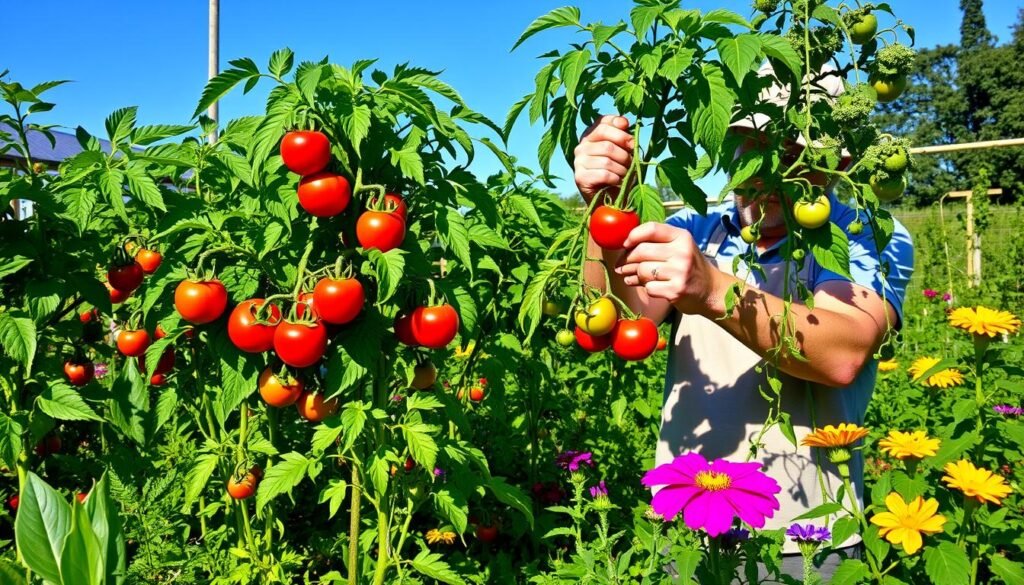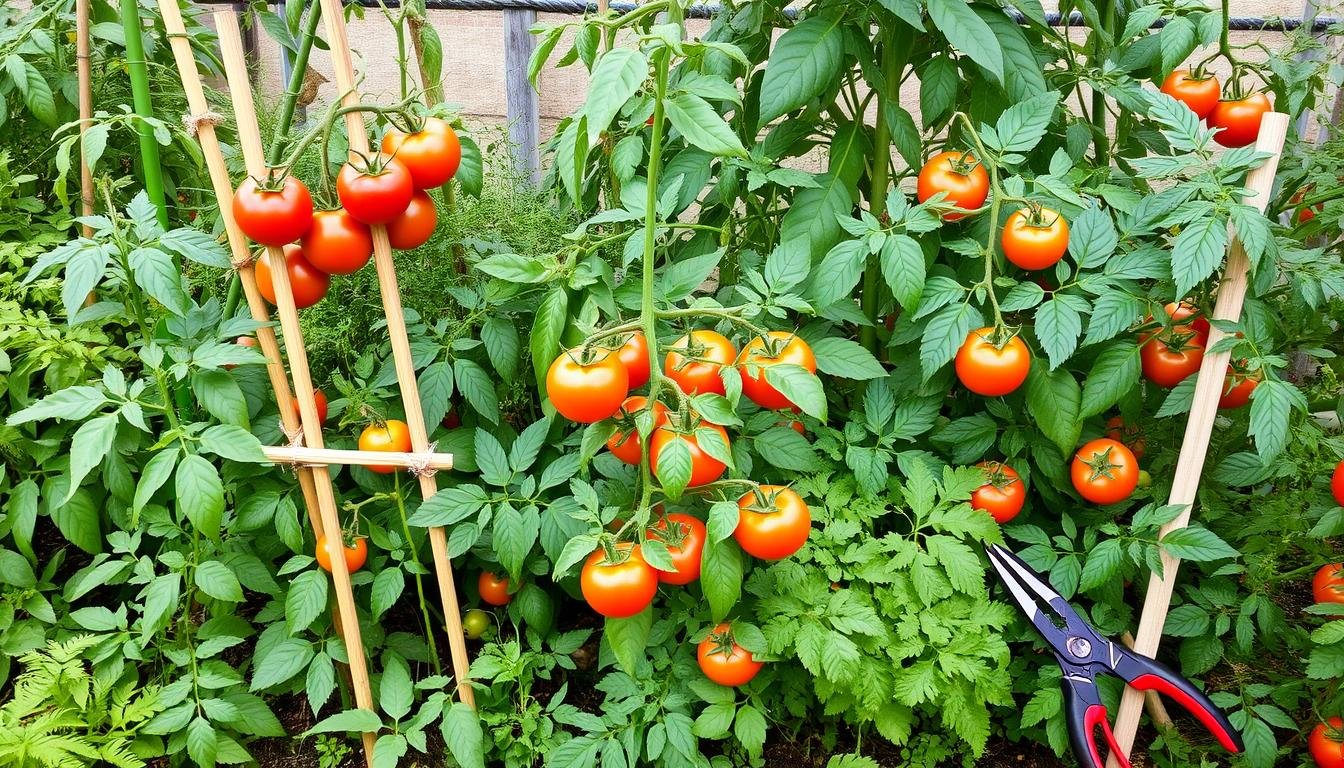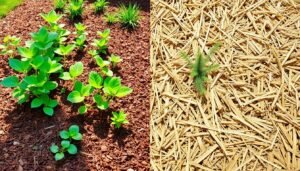Managing tomato plant growth is key for a good harvest. I’ve learned that understanding how to keep tomato plant from getting too tall makes gardens healthier and improves both fruit size and quality. This article will share expert tips on managing tomato plant height.
From choosing the right plant types to effective pruning techniques, we’ll cover it all. Pruning tomato plants is essential for encouraging better fruit production. It helps plants focus on growing fruit rather than excessive height, leading to higher yields and healthier plants.
Key Takeaways
- Understand the types of tomato plants for better height management.
- Implement a consistent pruning schedule to enhance air circulation and reduce disease.
- Utilize appropriate planting techniques to promote strong growth.
- Choose support methods that accommodate your plant’s growth habits.
- Maintain optimal watering and feeding practices to control growth.
- Protect your plants from excessive sun exposure during peak seasons.
Table of Contents
Understanding Tomato Plants
Tomato plants come in many types for different gardening needs. Knowing these types of tomato plants is key for growing them well. I’ll look at how determinate and indeterminate plants differ. This helps with understanding tomato growth and managing their height.
Types of Tomato Plants
I focus on two main types: determinate and indeterminate. Each type has its own care needs, especially for height control.
- Determinate Tomato Plants: Known as bush varieties, they grow up to 4 to 5 feet tall. They produce all their fruit at once. This makes them great for canning and easy to manage.
- Indeterminate Tomato Plants: These keep growing all season, producing fruit for months until frost. They need lots of support and benefit from pruning.
Growing Habits: Determinate vs. Indeterminate
The growth habits of determinate vs. indeterminate tomato plants are crucial. Determinate tomatoes grow well with little care. Indeterminate tomatoes need regular care, like pruning and support.
| Feature | Determinate Tomatoes | Indeterminate Tomatoes |
|---|---|---|
| Growth Height | 4-5 feet | Unlimited growth |
| Fruit Production | Single crop at once | Continuous throughout season |
| Support Needs | Minimal | High |
| Pruning | Not required | Beneficial for growth control |
Knowing these types helps me pick the right care for my plants. This way, I get the best growth and yield while keeping their height in check.
Choosing the Right Varieties for Height Control
Choosing the right tomato varieties is key to managing plant height. Focus on dwarf tomato varieties and heat-tolerant tomato varieties. This ensures growth in different climates without too much height. Knowing your garden’s needs helps pick the best varieties for a great harvest.
Dwarf Tomato Varieties
Dwarf tomato varieties are great for small spaces. They grow 18 to 24 inches tall. This makes them perfect for raised beds or containers.
The Litt’l Bites variety is especially small, reaching just 2 feet. The Bush 506 grows 1.5 to 2 feet tall. These varieties make it easy to enjoy fresh tomatoes without needing to stake them.
Heat-Tolerant Varieties for Different Climates
Knowing how tomatoes react to the weather helps in choosing the right ones. For example, the Heatmaster variety does well in warm weather. It’s very resistant to high temperatures.
Heat-tolerant varieties like Early Girl and others don’t need to grow very tall. They still produce lots of fruit, even in tough weather.
| Variety | Type | Height | Notes |
|---|---|---|---|
| Litt’l Bites | Dwarf | Up to 2 ft | Most compact, ideal for small spaces |
| Bush 506 | Dwarf | 18″ – 24″ | Great yield in limited height |
| Heatmaster | Heat-Tolerant | 3 – 4 ft | Thrive in hot climates |
| Early Girl | Heat-Tolerant | 3 – 4 ft | Produces good quality fruit in various conditions |
Choosing the right varieties controls plant height and improves gardening. With the right planning, I can grow tasty, easy-to-manage plants. They fit perfectly in my garden and climate.
How to Keep Tomato Plant from Getting Too Tall
Keeping tomato plants the right size is key for good growth and lots of fruit. I’ve found ways to manage light exposure and planting techniques for tomatoes. These help keep my plants at a good height.
Light Exposure Management
Tomato plants need lots of sunlight to grow well. I make sure they get 6-8 hours of direct sunlight each day. This helps them stay short and strong.
If sunlight is scarce, I use grow lights. I also rotate seedlings every day. This keeps them growing evenly and not leaning too much towards the light.
Planting Techniques for Stronger Growth
Using the right planting techniques for tomatoes helps control their height. Planting seedlings deep helps their roots grow strong. This makes the plants more stable and healthy.
I also make sure to space plants 2-3 feet apart. This stops them from getting too tall as they compete for sunlight. Using trellises or cages helps manage height and keeps air moving, which is good for the plants.
| Height Management Strategy | Description |
|---|---|
| Light Management | Ensure 6-8 hours of sunlight and use grow lights if necessary. |
| Deep Planting | Plant seedlings deeper for better root support and stability. |
| Spacing | Space plants 2-3 feet apart to prevent overcrowding. |
| Support Structures | Use trellises or cages to control the height and improve airflow. |
The Importance of Pruning Tomato Plants

Pruning tomato plants is key to keeping them healthy and productive. It helps control their height and boosts fruit production. I focus on removing suckers and pruning at the right time and way.
Removing Suckers
Removing suckers is crucial for indeterminate tomato plants. Suckers grow between the main stem and branches. If not removed, they take too much energy, making the plant less productive.
I check for suckers often and prune them to help the plant grow better. When cutting off big suckers, be careful to avoid wounds that can get infected.
Timing and Techniques for Effective Pruning
Pruning at the right time is important. I start pruning when my tomato plants are 12 to 15 inches tall. This helps them grow stronger and produce bigger fruit.
I prune in the early morning when plants are less stressed. For indeterminate varieties, I prune the lowest two feet of foliage. This helps prevent disease, especially in humid areas.
Pruning also improves airflow and makes the plant healthier. Sometimes, I use the suckers to grow new plants. I put them in water to start new roots before planting. This way, I make the most of my gardening efforts.
| Pruning Technique | Benefit | Frequency |
|---|---|---|
| Removing Lower Leaves | Improves airflow and reduces disease risk | Every few days |
| Trimming Suckers | Promotes larger fruit and healthier plants | Weekly |
| Pruning to One Main Stem | Keeps the plant manageable and focused on fruit production | As needed |
Tomato Plant Support Methods
Tomato plants need good support, especially the tall ones. You can use staking or caging to help them. These methods keep the plants safe from damage and help air move around them.
Staking and Caging Techniques
For staking, use tall metal fence posts and galvanized wire. This setup is strong and keeps plants upright. Make sure to space the poles 120 to 140 cm apart.
Adding cross-bracing makes the support even better. It helps during storms or when the wind is strong.
If you like cages, pick sturdy ones that grow with your plants. Trellises are better, though. They make harvesting easy and keep fruits safe from slugs.
The Benefits of Trellising for Indeterminate Varieties
Trellising is great for indeterminate tomatoes. It lets them grow up, saving space in your garden. You can use the same trellis every year.
Adding eye bolts and nuts makes the trellis even better. It keeps the wire tight and stable.
Using red plastic mulch can help your tomatoes grow. It keeps weeds away and keeps the soil warm. A soaker hose is also good for watering. It keeps leaves dry, which stops diseases.
These tips can make your tomatoes healthier and more productive. For more gardening advice, check out this helpful resource.
Training Your Tomato Plants
Training tomato plants is key to keeping them the right height and shape. It also helps them grow healthy. Using string or twine for support is a big help in training.
Methods for Effective Training
There are many ways to train tomato plants to grow strong and healthy:
- Staking: Stakes are driven into the ground next to each plant. The stems are tied to the stakes with string or twine. This keeps plants upright and stops them from getting too crowded.
- Caging: Wire cages surround the plants. They grow up the cages, getting support from wind and rain.
- Trellising: Trellises are sturdy structures that plants are tied to. This helps them grow up, not out. It also keeps them away from soil splash that can cause disease.
Using String or Twine for Support
String or twine is a great way to support tomato plants. It ties the main stems to a vertical stake. This lets plants get more air and sunlight. It’s especially good for tall, sprawling plants.
As plants grow, you might need to adjust the string or twine. Prune plants every 5-7 days in June and July. This helps them grow better and prevents too much foliage that can block fruit from ripening.
| Technique | Advantages |
|---|---|
| Staking | Supports upright growth, eases access for harvesting, and enhances sun exposure. |
| Caging | Provides consistent support and protects from heavy winds and rain. |
| Trellising | Encourages vertical growth, reduces disease risk from soil splash, and saves garden space. |
Using these training methods makes caring for plants easier. It also helps them grow healthier. This leads to a better harvest. I’m looking forward to using these techniques in my garden.
The Role of Watering and Feeding in Growth Control
Managing water and nutrients is key for healthy tomato plants. Too little or too much water can cause problems. It’s important to find the right balance for growth.
Watering Techniques and Frequency
Water your tomato plants regularly to keep the soil moist. They need about 1-2 inches of water each week. This can change based on your area’s weather.
Drip irrigation is a good choice. It helps avoid diseases and saves water. Plants in containers dry out faster, so they need more water.
Don’t overwater. Too much water can harm the roots and cause diseases.
Types of Fertilizers for Optimal Growth
Choosing the right fertilizer is crucial for tomatoes. Start with nitrogen, then phosphorus to help them bloom and grow strong. Use an all-purpose fertilizer every three weeks until the tomatoes are ripe.
For blossom-end rot, use calcium nitrate. It helps when you plant and when the tomatoes grow. Knowing what your plants need helps them grow well and avoids problems.
Right nutrients and water are important for plant health and height. For more tips on growing tomatoes, check out this guide.
Seasonal Care to Maintain Plant Height
Seasonal care for tomato plants is key to keeping them healthy and tall. Each season has its own challenges. Knowing how to manage growth and protect from too much sun is vital for a good harvest.
Controlling Growth in Different Seasons
In the growing season, it’s important to control growth. Determinate tomatoes grow to a certain height, while indeterminate ones keep growing until frost. I use different methods to manage their height based on the season:
- In spring, I make sure to stake them properly for support.
- By mid-summer, I prune them to improve airflow and prevent disease.
- As fall comes, I cut back on foliage to focus on fruit production.
Protecting Plants from Excess Sun
Keeping plants from too much sun is also crucial. Too much sun can cause sun scald and make them grow too fast. This can hurt the quality of the tomatoes. Here’s how I protect them:
- I use shade cloth during the hottest parts of the day to keep them cool.
- I plant taller tomatoes near shorter ones to create shade.
- Checking on them often and watering in the morning helps keep them hydrated without too much sun.
By taking good care of my tomato plants seasonally, I help them grow well and avoid sun damage. This not only keeps them healthy but also makes them more productive and have better fruit.
Conclusion
Managing tomato plant growth is key. Choosing the right varieties, like dwarf or heat-tolerant ones, is a good start. Pruning helps too, focusing energy on fruit rather than height.
Supporting plants with stakes or trellises is also important. This keeps them the right size and healthy. Using light well, pruning on time, and caring for plants seasonally helps a lot.
Good gardening needs patience and watching plants closely. This way, cherry tomatoes can grow well and bring joy. With these tips, I can keep my garden thriving all summer.




